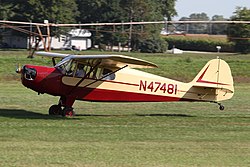Taylorcraft Model D.
| Taylorcraft Model D. | |
|---|---|
 DCO-65 (former military L-2-TA) |
|
| Type: | Light aircraft |
| Design country: | |
| Manufacturer: | |
| First flight: |
February 1941 |
| Production time: |
1941/42 |
| Number of pieces: |
200 + 29 as post-war production? |
The Taylorcraft Model D Tandem Trainer is a light aircraft made by the US manufacturer Taylorcraft Aviation in the early 1940s. After 200 machines had been built, production was switched to the military version L-2 .
history
In 1940/41 the demand for training machines, especially in the semi-military pilot training program (Civilian Pilot Training, CPT), increased steadily. While Taylorcraft was able to sell a larger number of the Model B to the United States Army Air Corps (USAAC) as part of the program , designs with back-to-back seats were considered more suitable. In 1940 half of all machines used for this purpose came from Piper, which the J-3 was able to offer with this seating arrangement. To better develop this market for itself, Taylorcraft developed the Model D, which again took up the tandem seat arrangement of the earlier Taylor J-2 . The Model D must not be confused with the Plus D of the British Taylorcraft Airplanes from which the Auster series was created.
The first version was the DC-65, which was unveiled to the public in February 1941 and received type certification on November 25, 1941. The standard engine was the Continental A-65 -8, but a Franklin 4AC -176 (DF-65) or Lycoming O-145 -B2 (DL-65) could also be installed. To identify the equipment with single or double ignition, the letters S or D have been added (e.g. DL-65S for single ignition and DL-65D for double ignition). The dimensions differed only slightly from those of model B, only the wingspan was reduced by about 18 cm due to the narrower cabin and the length was increased by 23 cm.
construction
As with all pre-war Taylor designs, the fuselage structure consisted of fabric-covered welded steel tubes. Taylorcraft tried to use as many parts as possible from the previous Model B for the Model D. However, this succeeded only to a limited extent as the main structural components between the two models were not interchangeable. In contrast to the Model B, the wing ribs were made of aluminum instead of wood. The cell received some reinforcements due to the expected increased stress in training operations. The tanks were in the wings and fed a collection tank behind the engine. The cowling was interrupted in the area of the engine cylinder heads, which were thus free in the air flow. The machine could be flown from both places.
The specifications of the designers John Hutmacher and Cameron Lusty also included the requirement for good all-round visibility, whereupon they lowered the upper strap of the fuselage framework ( Longeron ) to the pilot's shoulder height. When CG Taylor saw the first specimen in this form, he ordered that this be reversed in order to restore the typical external appearance of a Taylorcraft machine. The designers achieved this by placing a molded piece of plywood on the upper longeron. In the later military version L-2A, this "turtle hump" was removed again and replaced by a transparent panel.
Civilian specimens used by the military
- YO-57: four Model D with a Lycoming YO- 170-3, which have been evaluated for military use (USAAC serial no. 42-452 to 455), renamed O-57 and then L-2-TA
- L-2C: 13 requisitioned civilian model DC-65
- L-2D: a requisitioned civilian DL-65
- L-2E: 10 requisitioned DF-65s
The military L-2-TA, designated by Taylorcraft as DCO-65, corresponds in appearance to the civilian model DC-65.
Technical specifications
| Parameter | Data |
|---|---|
| crew | 1 |
| Passengers | 1 |
| length | 6.94 m |
| span | 10.80 m |
| height | 2.14 m |
| Wing area | 16.72 m² |
| Takeoff mass | 613 kg |
| Top speed | about 160 km / h |
| Climb performance | 150 m / min |
| Service ceiling | 4270 m |
| Range | 430 km |
| Engines | a Continental four-cylinder A- 65-8 boxer engine with 65 hp |
See also
literature
- Taylorcraft - A Complex Classic . In: AIR Enthusiast Forty-Five, March to May 1992, pp. 52-55
- Chet Peek: The Taylorcraft Story , Aviation Heritage Library Series, 1992, ISBN 0-943691-08-7
- John M. Andrade: US Military Aircraft Designations and Serials since 1909 , Midland Counties Publ., 1979, ISBN 0-904597-22-9
Individual evidence
- ↑ Chet Peek: The Taylorcraft Story, p. 125